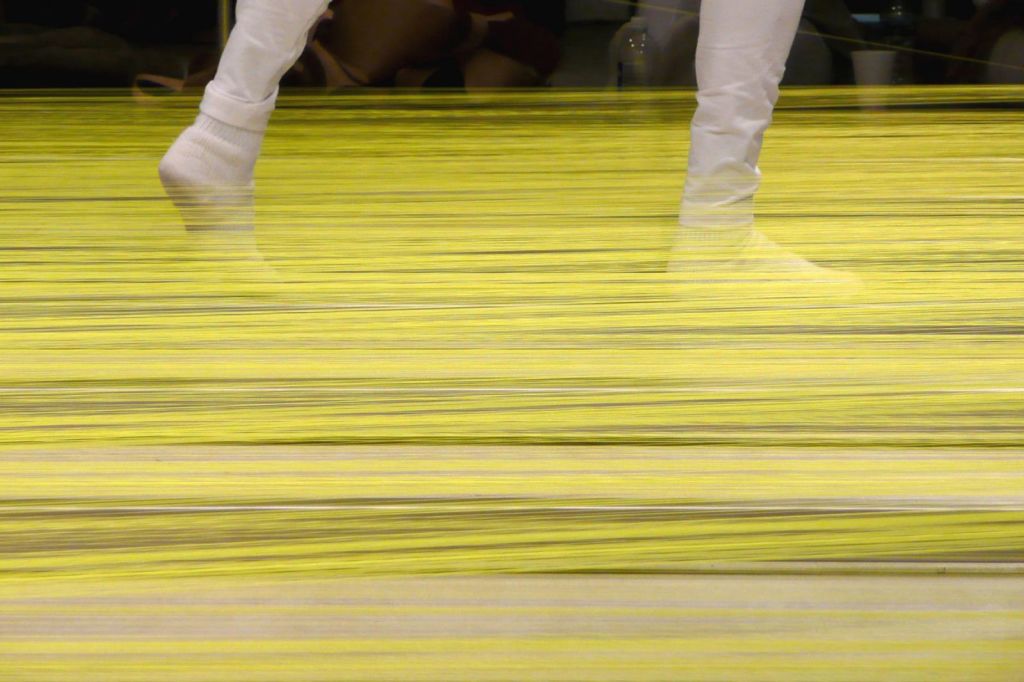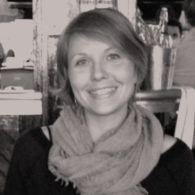Promeneur: Walking, Weaving, Wandering
Sheila Hicks’s work Promeneur is both an example and an outlier within her body of work. While Hicks was developing her weaving practice and experimenting with scale, color, and process, modernism was wrapping up, and the feminist movement was picking up speed. Unlike other female artists of her time who used textiles in their work, (for example Faith Ringgold, Betye Saar and Judy Chicago), Hicks was uninterested in using her work toward a feminist agenda. By the 1970s Hicks was already well shown and didn’t need or want the help of the feminist movement to assist her personal access the art world. According to Whitney Chadwick in her essay “Ancient Lines and Modernist Cubes,” because Hicks learned various textile traditions all over the globe, from men as well as women, she did not see her work as a part of the feminist movement.[1] However, the materials and processes important to Hicks’s work became bound with second wave feminism. Like other female artists in her time, for example Agnes Martin or Eva Hesse, whose art was not specifically invested in the feminist movement, Hicks’s work has been retrospectively included as a component of the movement.
Hicks made historical textile works, conversation sculpture, painting, architecture, and large-scale installations. Throughout these waves in her practice, Hicks has always created what she calls her “small weavings.” She estimates she has made about a thousand of these small weavings since graduate school on a little portable loom that is made of stretcher bars. Hicks calls these weavings her “personal expressions,” “private investigations,” or “ramblings.”[2] Promeneur is one of these.

Sheila Hicks, Promeneur, 1988. buttonhole stich, synthetic monofilament, silk, 8 5/8 x 4 ¾ in. Cooper-Hewitt, National Design Museum, Smithsonian Institution, New York, Gift of Anonymous Donor. From Sheila Hicks: Weaving as Metaphor. New Haven, CT: Yale University Press, for The Bard Graduate Centre for Studies in the Decorative Arts, Design, and Culture, New York, 2006, 55.
While some of these weavings date back to her days at Yale, Promeneur is part of a more recent group of weavings called the White Drawing series.[3] The White Drawing series is the first of Hicks’s work to use synthetic fiber. She uses monofilament to create a nearly-invisible trellis for the silk or linen button knots to climb upon. Each of the seven of the works in this series is delicate and neutrally colored. She said of the White Drawing series: “These works, where all the conventions of weaving don’t apply, are like dancing on a harp of threads.”[4]
Hicks talks poetically about her work, and she also sometimes writes specific text to accompany a piece. A number of the “small weavings” are complemented by a few lines of text, guiding the audience toward her concept for that specific work. These lines are part of the piece, but in all cases Hicks sees “writing” or communication as both written and woven. She states, “The idea is to take a single pliable element—in this case, of course, a single thread, comparable to a thread of language—and to demonstrate, as you might weave ideas around a theme, the most that can be done with it from both the constructed and the sensuous sense. Because this is a medium where you can be both intellectual and sensuous at the same time.”[5]
Hicks’s statement seems especially true of her piece Promeneur—a French word that means walker, stroller, or rambler. The writing that accompanies the piece says, “A wind blown drawing of a continuous / silk line with loops and knots clings to / a translucent scaffolding.” Her words are precisely descriptive about this piece; it looks like a graceful, freely-moving line drawing that precariously clings to itself. It sounds like a piece of music where only a few notes carefree notes tie one part of the piece to the next.
Walking has a long history as an artistic practice and as a contemplative structure. Since the peripatetic schools of ancient Greece, philosophers have used a leisurely stroll to converse, teach, and construct new interpretations of the urban environment. Promeneur likewise calls the viewer to a meandering path through a grid, a path with a rich contextual history. Compiled here is a select list of wanderings for Hicks’s promeneur.
Flâneur
Flâneur, a near-synonym to promeneur, is a term used by both Charles Baudelaire and Walter Benjamin to describe a bourgeois man strolling the streets at leisure, idly walking through the city.[6] According to Benjamin, a flâneur is supposed to wander through the city effortlessly, without a plan, engaged in a disaffected critique of urban life.
In The Arcades Project, Benjamin writes that the city is transformed into a landscape for the flâneur.[7] It is not a place to shop, socialize, or spend leisure time; it is a place for contemplation. Benjamin’s practice of walking for cultural exploration or understanding sounds almost meditative. He likens the experience of the flâneur to that of an “ascetic animal” who is uninterested in the “temptations of shops, of bistros, of smiling women” and whatever else might try to satisfy him.[8]
Dérive
Guy Debord wrote in the 1950’s about the dérive, an unplanned urban journey.[9] Wandering or drifting through the city, according to Debord and the rest of the Situationists International, is a way of using experimental behavior to create political movement. The psychogeographical maps of the city created by the Situationists resonate with the map-like appearance of Hicks’ Promeneur. The line of silk wandering through monofilaments has a feeling of playfulness invited by the dérive.
Automatic Drawing
Automatic drawing, a surrealist practice, also resonates with Promeneur. Automatic drawing was used by surrealists including Andre Masson, Joan Miró, and André Breton. These artists drew while allowing (or imagining they were allowing) the hand to move without direction from the brain. Thus, the drawing produced would unveil the subconscious.[10] Promeneur reflects the feeling of an automatic drawing; tentative yet flowing and free, it looks unplanned.
Walking in the City
Published in 1980, Michel de Certeau’s book The Practice of Everyday Life included a chapter entitled “Walking in the City.” He compared walking in the city to language, which mirrors Hicks’s ideas about weaving and language. De Certeau bemoaned the industrialization of the cities and the subsequent lack of areas to roam, wander, and contemplate. To him, each architectural piece of a city is like a word, and our walking puts those words together into language. Walking through a city allows its language to stay alive.
Wanderlust
Rebecca Solnit, who has recently written about walking in her book Wanderlust, beautifully connects the concept of walking (or weaving) to language. She says:
The rhythm of walking generates a kind of rhythm of thinking, and the passage through a landscape echoes or stimulates the passage through a series of thoughts. This creates an odd consonance between internal and external passage, one that suggests that the mind is also a landscape of sorts and that walking is one way to traverse it. A new thought often seems like a feature of the landscape that was there all along, as though thinking were traveling rather than making.[11]
Walking the Warp
Contemporary artist Ann Wilson recently completed a series of artworks called Walking the Warp, which have taken place in a variety of cities. In 2008, Wind Up: walking the warp was performed at Rhona Hoffmann gallery over a few days.[12] Wilson explores similar themes to Hicks in her work but she begins from a different place. Wilson embraces her position as a feminist weaver and is conscious of the recent history of weaving, including Hicks’s work, that has come before her.

Anne Wilson, Wind Up: walking the warp, January 20-25, 2008, documentation of performance. From Wind-Up: walking the warp, Research Document, 2008.
Like Hicks’s practice, Wilson’s practice, and particularly her piece Wind Up: walking the warp, began with looking at various weaving practices around the globe. Wilson was interested in the ways that the warp, which acts as the structural support for a weaving, is created.[13] In this performative piece Wilson and team of artists create the warp for a forty-yard-long weaving by methodically walking neon thread through a seventeen by seven foot frame. The score is as follows:
Inhaling, step right, then left, then right again.
Exhaling, step left, then right, then left again.
Repeat until the bobbin of thread is “empty” (approximately 30 minutes).
This piece speaks to the history of winding the warp and directly to the practice of meditative walking. Promeneur is an object that visually reflects the meditative walk or wandering. Weaving and walking are both repetitive actions that can become meditative, allowing room for other things to occur (meditation, spiritual enlightenment, intellectual curiosities about the city). Examining Promeneur and Wind Up: walking the warp together asks for a reconsideration of Hicks’s work in relation to a feminist artistic discourse. While Hicks may not view her work as feminist, it holds an important place in the canon of feminist art, especially for fiber artists.
Promeneur is a work which illustrates a success of feminism in that bourgeois men are no longer the only ones allowed to wander to contemplate. In contrast to the history of women’s work, which largely consisted of repetitious motions and was masked by function (quilts, knitted socks, patterned sweaters), Promeneur meanders boldly. The process of its making is transparent and present in its physicality. Instead of being stuck in dysfunctional repetition, Promeneur ‘s rhythm is a form of meditation. Creating something not meant for consumption and walking somewhere with no destination in mind are radical acts, no less for Hicks than for any philosopher.
[1] Simon, Joan and Susan C. Faxon, Sheila Hicks: 50 Years, (New Haven, Connecticut: Addison Gallery of American Art and Yale University Press, 2010), 184.
[2] Ibid., 91.
[3] Ibid., 54.
[4] Ibid., 54.
[5] Munro, Eleanor, Originals: American Women Artists, (New York: Simons and Schuster, 1979), 368.
[6] Benjamin, Walter, Michael W. Jennings, ed., Charles Baudelaire: The Writer of Modern Life. (London: England, Harvard University Press, 2006), iv.
[7] Benjamin, Walter, The Arcades Project. (Cambridge, Massachusetts: Harvard University Press, 1999), 417.
[8] Ibid., 417.
[9] Foster, Hal, et al. Art Since 1900. (New York, New York: Thames and Hudson, 2004.), 394.
[10] Ibid., 137.
[11] Solnit, Rebecca. Wanderlust: A History of Walking. (New York: Penguin Books, 2000), 5.
[12] Wilson, Anne, Wind-Up: walking the warp, Research Document, Chicago, 2008.
[13] Ibid.



Dilettante Mail
Get updates from us a few times a year.